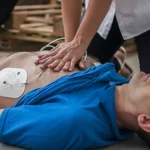Find out how to administer basic first aid to soft tissue injuries for accident victims among other first aid techniques.
Everyone, both children and adults are susceptible to soft injuries during accidents. While they are the most common form of injuries and might be life-threatening to the victim, soft injuries only pose a threat depending on their intensity.
Serious soft tissue damages may pose a real threat to human life if not handled properly, they include lacerations and stubbing on the abdomen. One needs to have the right training to handle emergencies like this and many others.
Apply today for first aid and CPR training course and become a fully CPR certified first aider of value to your family and society at large. Below are a few first aid procedures you could use to handle various forms of damage to the soft tissue of the human body. Along with first aid certificate, how long does CPR certification last? It lasts for 2 years and when you are near expiry, you can take the CPR BLS recertification classes.
First Aid for Wounds (Open and Closed)
Wounds can only be in two categories, open wounds and closed wounds. Closed wounds are not complicated and, in most cases, cleaning the area and applying an ice pack can be relieving. The ice packs are meant to reduce the pain being felt by the victim and also decrease blood outflow from the wound, in other words, control bleeding until medical emergency help arrives at the scene. While waiting for specialized help, assist the victim to get comfortable as you check for any other injuries they may have sustained.
Open wounds, on the other hand, could be slight or deeper cuts into the skin layers. Ascertain the intensity of the wound before beginning your first aid. Ensure you control bleeding from the victim by applying direct pressure. Once the bleeding stops you can prevent infections by sterilizing the wound and lastly dress the wound appropriately.
Burns First Aid
Burns in smaller accidents could damage the top skin layers although the damages may go extreme in worst situations. Before beginning your first aid, determine the intensity of the burn. Remember the deeper the burn goes, the more dangerous it is for the victim.
Treatment for burns should only commence after withdrawing the victim from the cause of the burn. For thermal burns, you can then cool with plenty of water and use the sterile dressing to loosely cover the burns. Chemicals burns may tend to continue should the substance remain on the victim’s skin. Wash with clean running water or brush the chemical off while wearing gloves.
Embedded Object Injuries
Embedded objects like metal and glass should never be removed from the victim’s body by a first aider. Try dressing the wound comfortably to prevent any form of motion of the embedded object. Bandage the dressings and wait for emergency help to arrive and administer advanced medical help. For smaller objects like splinters, tweezers could be carefully used to remove them before sterilizing and dressing.
Abdominal Injuries
They may include any injuries sustained to the chest and general abdomen. Determine if they are closed or open injuries before administering help.
Call for emergency help as soon as you notice any injuries to the abdomen. Put your gloves on and get the victim in a comfortable position before commencing. Do sterile dressing loosely and use plastic wrapping to do it.
Conclusion
Avoid applying pressure to control bleeding rather than wait for more advanced medical help to arrive. Enroll for first aid and CPR certification today and learn more skills that could help you become a fully certified first aider. Feel free to reach out anytime at 1-888-277-7865 or contact us on our website for free CPR classes.













